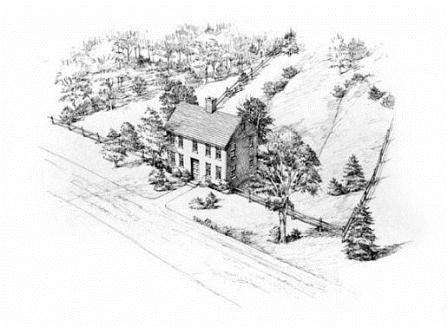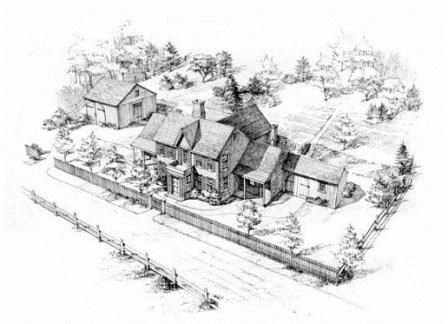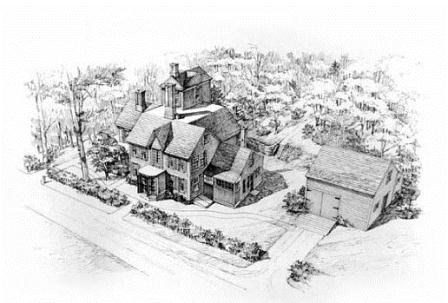
Over more than three hundred years, The Wayside and its families witnessed and influenced both Concord's and America's recorded history.In addition to its authors, the occupants of the house included Minute Man Samuel Whitney, farmers, artisans, reformers, and teachers.They were connected to both everyday occurrences and sweeping events that shaped America's heritage.Today, The Wayside is known as The Home of Authors for the three literary families that lived in it, the Alcotts, Hawthornes, and Lothrops who added to America's literature and to their home. 1635: Town of Concord established. 1686: First known record of land ownership for The Wayside property.Owned by Nathaniel Ball, a Concord yeoman;it is not known if there was a house on the property at that time. 1688: Nathaniel Ball transferred "half my house Lott" to his son, Nathaniel, Jr. three days before his marriage to Mary Brooks.Their son Caleb was born in 1690. 1717: First deed citing a house on the property, in which Caleb Ball sold the house to Samuel Fletcher, a glazier. 1717-1769: The Wayside saw a succession of owners, most of whom were farmers and artisans. 1769-1778: Owned and lived in by Samuel Whitney, a merchant from Boston.Whitney would assume a strong role in town affairs, which included his position as muster master of the Concord Minute Men on April 19, 1775. 1775-1776: The Wayside was occupied by eminent scientist, Professor John Winthrop during the nine months that Concord hosted Harvard College during the Siege of Boston. 1778-1844: Owned by a succession of five families involved in farming and trades.

1845-1852: Educator and philosopher Amos Bronson Alcott and his wife Abigail owned the home and called it "Hillside." Here many of the scenes later immortalized in Little Women represent events of their life in this house:
For the Alcotts, the house was actually from Horatio Cogswell by Samuel Sewall, a cousin of Mrs. Alcott's, and the Rev. Samuel J. May, her brother.They were acting as Trustees under the will of Mrs. Alcott's father, Colonel Joseph May.This arrangement was designed to protect the home from the many creditors of Bronson Alcott, who was heavily in debt. 
1852: Acclaimed author Nathaniel Hawthorne purchased the house, renaming it "The Wayside."He moved in with his wife Sophia (Peabody), and their young children Una, Julian, and Rose. 1853-1860: Appointed U.S. Consul to Liverpool, England by his friend, President Franklin Pierce, Hawthorne and his family departed for Europe in 1853.After Hawthorne's appointment concluded in 1857, the family spent time in England, France, and Italy before returning to Concord in 1860.During this time, the house was rented to members of Sophia's family, including her sister Mary (Mrs. Horace) Mann.The Alcotts also lived here for several weeks in 1857 until their new home, "Orchard House," was readied for their occupancy. 1860-1864: After returning from Europe, Hawthorne spent the last four years of his life at The Wayside with his family. The Alcotts were his neighbors, now residing next door at Orchard House. 1870: Sophia Hawthorne sold The Wayside to Mrs. Abby Gray whose son George painted the murals on the ceiling of the Tower Study's "sky parlor" in memory of Hawthorne. 1871-1879: Rented, then owned by Miss Mary C. Pratt, who ran the "Wayside School for Young Ladies" in her home. 1879-1883: Owned by Hawthorne's youngest child Rose and her husband George Parsons Lathrop.For a portion of late 1881 to early 1882, while the Lathrops were in Boston, the house was occupied by the wife and seven children of Julian Hawthorne, and later, Julian as well.When Julian and his family left The Wayside during the summer of 1882, George and Rose Lathrop returned until December of that year. 
1883: Bought by Boston publisher Daniel Lothrop and his wife Harriett, who wrote The Five Little Peppers and other children's books under the pen name "Margaret Sidney."The Lothrops greatly admired Hawthorne's writing and wanted to make as few changes as possible to the only home he had ever owned. 1884: Margaret Lothrop was born at The Wayside.Eighty years later, she sold the property to the National Park Service. 1924: Following the death of her mother Harriett (her father Daniel had died in 1892), Margaret became the last of The Wayside's private owners.She had been teaching sociology at Stanford University since 1915.During her years at The Wayside, Margaret devoted 40 years of her life to providing tours and preserving this important and historic literary home. 1963: The Wayside was designated a National Historic Landmark. 1965: The Wayside became a part of Minute Man National Historical Park and the first site of literary significance acquired by the National Park Service. 1971: The Wayside opened to the public after extensive renovation by the National Park Service, aided by Margaret Lothrop until her death in 1970. 1975: The Wayside barn was restored and converted into a visitor center. 1985: The Wayside was designated a National Historic Landmark for the second time. 2012-2016: The Wayside and Wayside Barn were closed for extensive renovations by the National Park Service. 2016: The Wayside reopens to the public in time for the Centennial celebration of the National Park Service. |
Last updated: May 24, 2016
